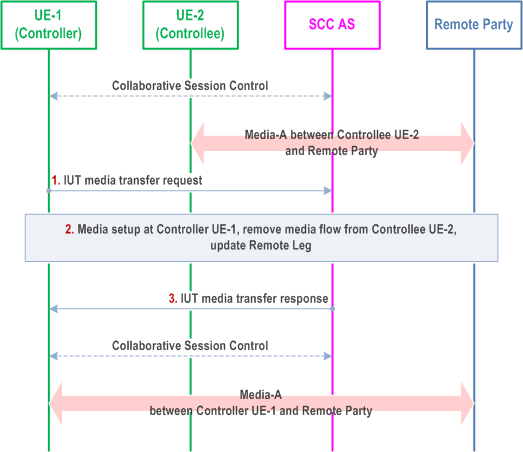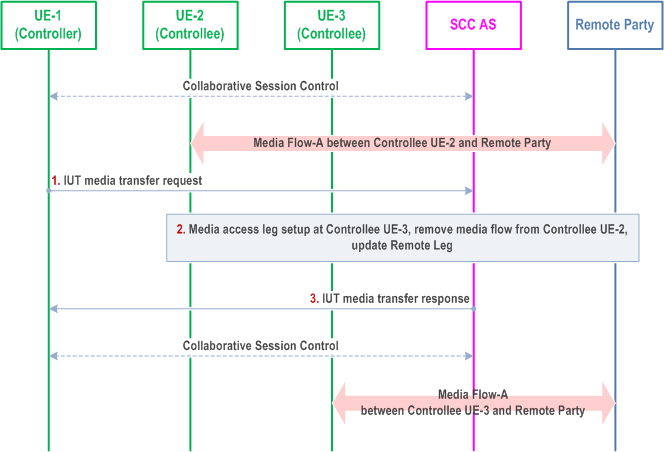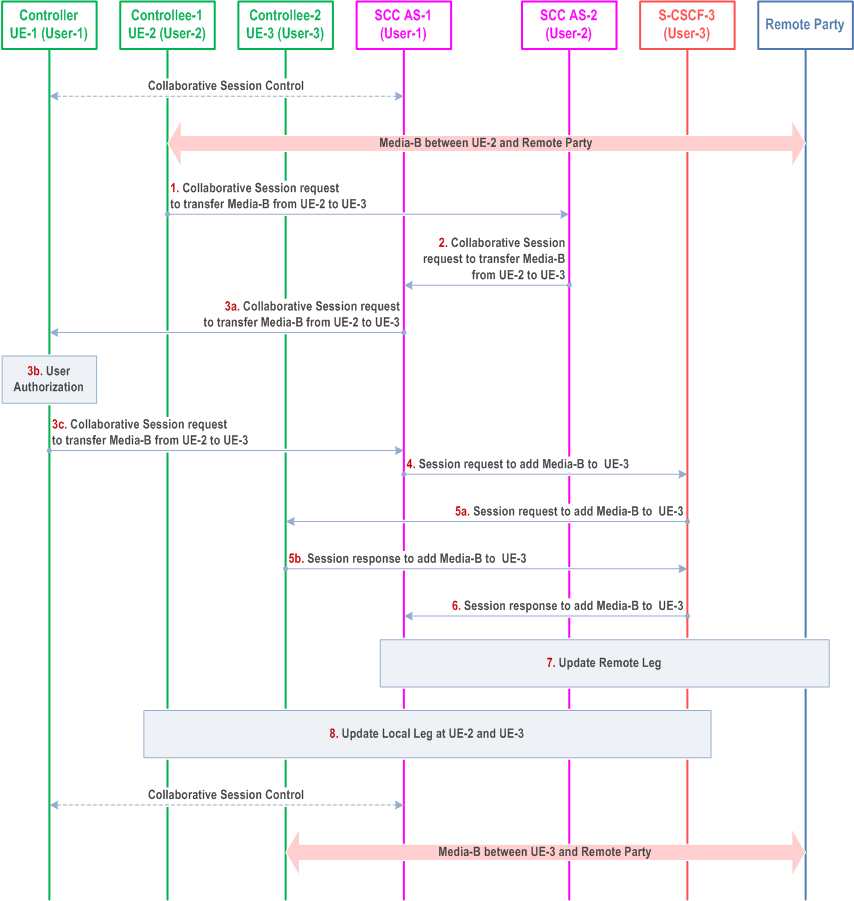Content for TS 23.237 Word version: 18.0.0
0…
4…
5…
5.4…
6…
6.2…
6.2.2…
6.3…
6.3.2…
6.3.2.1.3…
6.3.2.1.7…
6.3.2.1.9…
6.3.2.2…
6.3.2.3…
6.3.2.3.6…
6.3.3…
6.4…
6a…
6a.3…
6a.4…
6a.4.3…
6a.4.5…
6a.4.7…
6a.4a…
6a.5…
6a.6…
6a.7…
6a.8…
6a.9…
6a.10…
6a.11…
6c…
7…
A…
B…
C…
6a.3 Media Transfer within Collaborative Session
6a.3.1 Controller UE initiated media transfer from Controller UE to Controllee UE
6a.3.1.1 Controller UE and Controllee UE belong to the same subscription
6a.3.1.2 Controller UE and Controllee UE belong to different subscriptions
6a.3.2 Controller UE initiated media transfer from Controllee UE to Controller UE
6a.3.3 Controller UE initiated media transfer from Controllee UE to another Controllee UE
6a.3.3.1 Controller UE and Controllee UEs belong to the same subscription
6a.3.3.2 Controller UE and Controllee UEs belong to different subscriptions
6a.3.3a Controllee UE Initiated Transfer Media from one Controllee UE to another Controllee UE
...
...
6a.3 Media Transfer within Collaborative Session p. 111
6a.3.1 Controller UE initiated media transfer from Controller UE to Controllee UE p. 111
6a.3.1.1 Controller UE and Controllee UE belong to the same subscription |R10| p. 111
A Collaborative Session is already established using procedures shown in clause 6a.2. Following is an information flow for UE-1 performing media transfer to UE-2; after the transfer, the UE-1 keeps the role of the Controller UE, and UE-2 is Controllee UE. If UE-2 is not involved in the Collaborative Session controlled by UE-1 before the media transfer, there is at least another Controllee UE involved in the Collaborative Session before the media transfer, which is not shown in the information flow.

Step 1.
When the above transfer is completed the SCC AS retains the service state (e.g. media flows status) of UE-1 and UE-2, and the UE-1 retains the control of the Collaborative Session.
UE-1 sends IUT media transfer request to the S-CSCF to transfer the Media-A from UE-1 to UE-2. The IUT media transfer request shall include the enough information for the SCC AS to:
Step 2.
- identify that the transferred media flow is Media Flow-A;
- identify that the source of the transferred media flow is UE-1;
- identify that the target of the transferred media flow is UE-2;
- keep the control of the Collaborative Session in UE-1.
The SCC AS performs authorization as specified in clause 6a.12, then sends transfer request to establish a session with UE-2 for the Media Flow-A, removes Media Flow-A from UE-1, and updates the Remote Leg using the Remote Leg Update procedure as specified in clause 6a.1.2.
Step 3.
The SCC AS sends media transfer response to UE-1.
6a.3.1.2 Controller UE and Controllee UE belong to different subscriptions |R10| p. 112
The information flow below illustrates a transfer of media flow scenario in which the Controller UE transfers a flow to a UE that belongs to another user.

There are Media-A and Media-B between Controller UE-1 and remote party.
Step 1.
After the above operation, Media-B has been transferred from Controller UE-1 to Controllee UE-2.
UE-1 sends a request towards SCC AS-1 to transfer Media-B to UE-2. The request includes enough information for the network to:
Step 2.
- identify that the media flow to be transferred is Media-B;
- identify that the source of the media flow to be transferred is UE-1;
- identify that the target of the transferred media flow is UE-2.
S-CSCF-1 forwards the request to SCC AS-1.
Step 3.
SCC AS-1 authorizes the request from UE-1 as specified in clause 6a.12.
Step 4.
SCC AS-1 sends a request towards UE-2 to setup Media-B on UE-2. The request includes enough information for the network to:
Step 4a.
- identify the source of the transfer request as UE-1;
- identify the remote party;
- identify that the media flow to be transferred is Media-B;
- identify that the source of the media flow to be transferred is Controller UE-1;
- identify that the target of the media flow to be transferred is Controllee UE-2.
S-CSCF-1 forwards the request towards UE-2.
Step 5.
If UE-2 is an IUT subscriber, the request is routed via SCC AS-2 which checks that UE-2 is authorized to receive the request. If so, SCC AS-2 notes that this request relates to the establishment of a Collaborative Session so that any requests by UE-2 related to this Collaborative Session will be forwarded back towards SCC AS-1. A Session Setup request is then routed on towards UE-2. If UE-2 is not an IUT subscriber, S-CSCF-2 routes the request according to normal procedures.
Step 6.
S-CSCF-2 forwards the Session Setup request to Controllee UE-2.
Step 7.
UE-2 sends a Session Setup response towards SCC AS-1.
Step 8 - 9.
S-CSCF-2 routes the response back towards SCC AS-1 - via SCC AS-2 if UE-2 is an IUT subscriber.
Step 10.
S-CSCF-1 forwards the session setup response to SCC AS-1.
Step 11.
SCC AS-1 removes Media-B from UE-1, updates Remote Leg and finishes Access Leg establishment for setting up Media-B between remote party and UE-2.
6a.3.2 Controller UE initiated media transfer from Controllee UE to Controller UE p. 113
A Collaborative Session is already established using procedures shown in clause 6a.2, the UE-1 keeps the role of the Controller UE, and UE-2 is Controllee UE. Following is an information flow for UE-1 initiating media transfer from UE-2 to UE-1.

Step 1.
When the above transfer is completed the SCC AS retains the service state (e.g. media flows status) of UE-1 and UE-2, and the UE-1 retains the control of the Collaborative Session.
UE-1 sends IUT media transfer request to the SCC-AS to transfer the Media-A from UE-2 to UE-1. The IUT media transfer request shall include the enough information for the SCC AS to:
Step 2.
- identify that the transferred media flow is Media-A;
- identify the source of the media flow is UE-2;
- identify that the target of the transferred media flow is UE-1;
The SCC AS performs authorization as specified in clause 6a.12, then initiates the transfer by setting up Media-A towards Controller UE-1, removing Media-A from Controllee UE-2, and updates the Remote Leg using the Remote Leg Update procedure as specified in clause 6a.1.2. After the transfer, Media-A will be between Controller UE-1 and remote party.
Step 3.
The SCC AS sends media transfer response to UE-1.
6a.3.3 Controller UE initiated media transfer from Controllee UE to another Controllee UE p. 114
6a.3.3.1 Controller UE and Controllee UEs belong to the same subscription |R10| p. 114
UE-1 and UE-2 are engaged in a Collaborative Session established using procedures shown in clause 6a.2 for which UE-1 is the Controller UE and UE-2 is a Controllee UE. UE-3 might or might not be part of the Collaborative Session before the media transfer. There is media flow, Media-A, between UE-2 and Remote Party. The following Figure presents an information flow of UE-1 performing IUT media transfer from UE-2 to UE-3 after which UE-1 retains the role of the Controller UE and UE-3 becomes Controllee UE.

Step 1.
UE-1 sends IUT media transfer request to the SCC AS to transfer the Media Flow-A from UE-2 to UE-3. The IUT media transfer request shall include the enough information for the SCC AS to:
Step 2.
- identify that the transferred media flow is Media Flow-A;
- identify that the target of the transferred media flow is UE-3;
- keep the control of the Collaborative Session in UE-1.
The SCC AS performs authorization as specified in clause 6a.12, then sends request to establish Access Leg on UE-3 for Media Flow-A, removes Media Flow-A from UE-2, and updates the Remote Leg using the Remote Leg Update procedure as specified in clause 6a.1.2.
Step 3.
The SCC AS sends media transfer response to UE-1.
When the Inter-UE Transfer is completed, UE-1 keeps the Collaborative Session Control.
6a.3.3.2 Controller UE and Controllee UEs belong to different subscriptions |R10| p. 115
For Controller and Controllee UEs belonging to different subscriptions, the following information flow shows the flow of media transferring from a Controllee (UE-2) to another Controllee (UE-3) initiated by Controller (UE-1). As a pre-requisite, there exists a Collaborative Session with two media flows, Media-A on the Controller UE (UE-1) and Media-B on the Controllee UE (UE-2). UE-3 might or might not be part of Collaborative Session before the media transfer. Furthermore, UE-1, UE-2 and UE-3 profiles are served by different S-CSCFs, S-CSCF-1, S-CSCF-2 and S-CSCF-3, respectively. For simplicity, S-CSCF-1 is not shown in the following Figure.

Step 1.
UE-1 sends a Collaboration session request to SCC AS-1 to transfer Media-B from UE-2 to UE-3. The Collaborative Session request includes enough information for the network to:
Step 2.
- identify that the media to be transferred is Media-B;
- identify that the media to be transferred is currently on UE-2;
- identify that the media to be transferred to is UE-3;
- identify the session that contains of the transferred media flow to be transferred;
- keep the control of the Collaborative Session in UE-1.
SCC AS-1 verifies that UE-1 is the Controller UE and therefore is authorized to release the media from a Controllee UE-2 with a user belonging to another subscription and performs authorization as specified in clause 6a.12.
Step 3.
SCC AS-1 sends Session request to add Media-B to UE-3 via S-CSCF-3. Media-B in UE-3 is kept inactive until the remote end is updated. The Session request includes enough information for the network to:
Step 4a.
- identify the source of the transfer request as UE-1;
- identify the remote party;
- identify that the media flow to be added is Media-B;
- identify that the source of the media flow to be transferred is Controllee UE-2;
- identify that the target of the media flow to be transferred is Controllee UE-3;
S-CSCF-3 forwards the Session request to UE-3.
Step 4b.
UE-3 sends a Session response to S-CSCF-3.
Step 5.
S-CSCF-3 forwards Session response to SCC AS-1.
Step 6.
SCC AS-1 updates remote leg with Remote Leg Update Procedure.
Step 7.
SCC AS-1 establishes the access leg at UE-3 and removes Media-B from UE-2.
Step 8.
SCC AS-1 sends the Collaboration Session Response message to UE-1 confirming the successful transfer of Media-B from UE-2 to UE-3.
When the Inter-UE Transfer is completed, UE-1 keeps the Collaborative Session Control.
6a.3.3a Controllee UE Initiated Transfer Media from one Controllee UE to another Controllee UE |R10| p. 117
This information flow shows the Controllee UE-2 transferring a media flow from the Controllee (UE-2) to another Controllee (UE-2). As a pre-requisite, there exists a Collaborative Session with a media flow, Media-B, on the Controllee UE (UE-2). Furthermore, Controller UE 1 and Controllee UE 2 profiles are served by different IUT SCC AS, SCC AS-1, SCC AS-2 which are in turn attached to S-CSCF 1, S-CSCF 2 respectively. For simplicity, the S-CSCFs are not shown in the following Figure.

Step 1.
When the Inter UE Transfer is completed UE-1 keeps the Collaborative Session control.
Controllee UE-2 sends a Collaborative session request to SCC AS-2 to transfer Media-B from UE-2 to Controllee UE-3. The Collaborative Session request includes enough information for the network to:
Step 2.
- identify that the media to be transferred is Media-B;
- identify that the source for the media to be transferred is Controllee UE-2;
- identify that the target for the media to be transferred is Controllee UE-3;
- identify the session that contains of the media flow to be transferred;
- Controller of the Collaborative Session is Controller UE-1.
SCC AS-2 authorizes the request from UE-2 as specified in clause 6a.12 and identifies that the session is a collaborative session anchored at SCC AS-1 and so forwards the "Collaborative session request to transfer Media-B" to SCC AS-1 which is the SCC AS for the Controller UE.
Step 3a-3c.
The SCC AS-1 sends a Collaborative session request to the Controller UE-1, and the Controller UE-1 authorizes the media transfer request.
Step 4.
SCC AS-1 sends the Session request to add media-B to UE-3 via S-CSCF-3. Media-B in UE-3 is kept inactive until the remote end is updated. The Collaborative Session request includes enough information for the network to:
Step 5a.
- identify the source of the transfer request as UE-1;
- identify the remote party;
- identify that the media flow to be transferred is Media-B;
- identify that the source of the media flow to be transferred is Controllee UE-2;
- identify that the target of the media flow to be transferred is Controllee UE-3;
S-CSCF-3 forwards the Session request to UE-3.
Step 5b.
UE-3 sends a Session response to S-CSCF-3.
Step 6.
S-CSCF-3 forwards Session response to SCC AS-1.
Step 7.
SCC AS-1 updates remote leg with Remote Leg Update Procedure.
Step 8.
SCC AS-1 activates media-B at UE-2 and releases media-B UE-3.